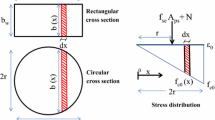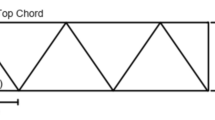Abstract
Calculating the ultimate load of a framed column in sway structures involves, in the currently used design method, the calculation of the column effective length and utilizing the interaction formulae or tables. Therefore no allowance is made for the presence of semi-rigid connections in the currently used design method. In this paper, a new formula to calculate the column ultimate load is proposed using simple model to simulate the behavior of practical steel columns in sway structures. This formula takes into account the effect of semi-rigid connections, the column rotational end restraints and the ratio of the applied horizontal to vertical loads. Moreover, the proposed method has the advantage of allowing for the influence of the column end moments resulted from the presence of the externally applied loads. In order to verify the accuracy of the proposed formula, several examples are presented in which the column ultimate load have been calculated using the proposed formula and the well known computer program STAAD.Pro. Comparing the obtained results of the proposed method with those obtained from STAAD.Pro has shown good correlation and therefore the accuracy of the proposed method to predict the behavior of practical columns has been verified.
Similar content being viewed by others
References
AISC ASD (1989). Manual of steel construction, Allowable Stress Design. 9 th ed., American Institute of Steel Construction, Chicago, IL, USA.
AISC LRFD (2005). Manual of steel construction, Load and Resistance Factor Design. American Institute of Steel Construction, Chicago, IL, USA.
ANSYS, Inc. (2009). Command reference’s guide. Canonsburg.
BS5950 (2000). Structural use of steelwork in building.- Part 1: 2000 Amendment. British Standard Institute.
Chikho, A. H. (2002). “An approximate formula for calculating lateral displacements of sway structures” R.J. of Aleppo Univ., Engineering Science Series, No.32.
Chikho, A. H. (1990). Frame behavior with semi-rigid connections. Ph.D. Thesis, Sheffield University, England.
Chikho, A. H. and Kirby, P. A. (1995). “An approximate method for the estimation of ultimate column load in steel sway frames.” Proc. Nordic Steel Conference'95, Malmo, Sweden, Vol. 2, pp. 711–718.
Chicko, A. H. and Nassani. D. E. (2009). “A simple model for calculating the ultimate load of a framed column in sway structures including the effect of semi-rigid connections.” Proc. 11 th Arab Structural Engineering Conference, King Fahed University of Petroleum & Minerals, Saudi Arabia.
Degertekin, S. O., Saka, M. P., and Hayalioglu, M. S. (2008). “Optimal load and resistance factor design of geometrically nonlinear steel space frames via tabu search and genetic algorithm.” Engineering Structures, 30, pp. 197–205.
Horne, M. R. and Merchant, W. (1965). The stability of frame. Pergamon Press, Oxford.
Johnson, R. and Anderson, D. (2011). Designers' guide to EN 1994-1-1, Eurocode 4: design of composite steel and concrete structures- Part 1.1: General rules and rules for buildings. Thomas Telford, London.
Limit States Design of Structural Steelwork (2001). Limit States Design of Structural Steelwork Based on Revised BS5950.- Part 1: 2000 Amendment. Third Edition, Spon Press.
MATLAB (1997). The language of technical computing, Version 5.0. The Mathworks Inc., Natick, Mass.
Nassani, D. E. (2011). Static and dynamic behavior of frames with semi-rigid connection. Ph.D. Thesis, Aleppo University, Syria.
Salmon, C. G., Johnson, E. J., and Malhas, F. A. (2009). Steel structures, design and behavior. Fifth Edition, Pearson Prentice Hall, USA.
Scerbo, J. S. (1996). “Analysis of steel frames with deformable beam to column connections.” M. Sc. Thesis, University of Manitoba, Canada.
STAAD.Pro (2012). Technical reference manual. Research Engineer International.
The Steel Construction Institute (2003). Steel designers' manual. 6th Ed., Blackwell Science Ltd, Paris, France.
Vega, G. and Xiao, R. (2014). “Advanced study of non-linear semi-continuous beam-column endplate connection and metal-decking oor modeling.” Journal of Constructional Steel Research, 95, pp. 191–197.
Author information
Authors and Affiliations
Corresponding author
Rights and permissions
About this article
Cite this article
Nassani, D.E., Chikho, A.H. A simple formula for estimating the column ultimate load with effect of semi-rigid connections. Int J Steel Struct 15, 31–38 (2015). https://doi.org/10.1007/s13296-014-1104-3
Received:
Accepted:
Published:
Issue Date:
DOI: https://doi.org/10.1007/s13296-014-1104-3




